
If you need a freelance travel writer or you would like to see your country, city, flight, etc., presented on the blog, drop me an email.
Find our more on Freelance Travel Writer page.
Here are things to do in Seville and what my travel was like to this city in the south of Spain. Although Seville struck me as a bit chaotic at first compering to Granada and Cordoba, its attractions left me speechless. If the first few things you think of when mentioning the city are flamenco, Guadalquivir or Columbus – you are in the right place!

SEVILLE SPAIN
The city’s history begins with Iberian tribes, but also with Phoenicians, Greeks and Carthaginians who established the bases of trade. Romans came in 250 BC and Scipio the African found the city of Italica in 48 BC. This is where famous Roman emperors Hadrian and Trajan were born. Caesar named the town of Hispalis (Seville) as the capital of the colony.
At the beginning of the 6th century, Seville becomes part of the Visigoth’s kingdom, only to be conquered by the Moors in 712 who named the city Isbiliya. Christians come in the 15th century, and this is where all the expeditions towards the New World were set off from.

It’s not surprising that the settlement grew during the explorations period and reached a population of 150,000. As soon as you enter the city it’s immediately clear that it’s big – and that’s probably the reason why the renowned Spanish nonchalance started to show. To be honest, I was a bit surprised at how everything worked in Malaga, Granada, and Cordoba that I visited prior to Seville. I even thought that the south of Spain is “definitely different from the rest of the country”. And then I came to Seville…

The idea was to take the high-speed train in a few days from Seville to Cadiz, so I wanted to buy the ticket before checking into my hotel and going to the Santa Justa railway station. Oh my… Counters and crowds!

Stood for about 10 mins to get to the information desk where the lady could barely speak any English and just showed me to wait in other lines. Stepped away to another line, and after another 15 mins, another lady showed me the sign above the counter (not much of a use, I don’t speak Spanish). I understood somehow that it only sells tickets for daily departures.

So, I queued for the third time, and waited for 10 more mins, only to be asked by the third lady “if I have the number”. She showed me where to get it, and then I just stood there before the empty counter, while the numbers were changing above (people who took them were not present), until finally, my number showed. And so, I explained that I need “a one-way ticket to Cadiz, in three days”.
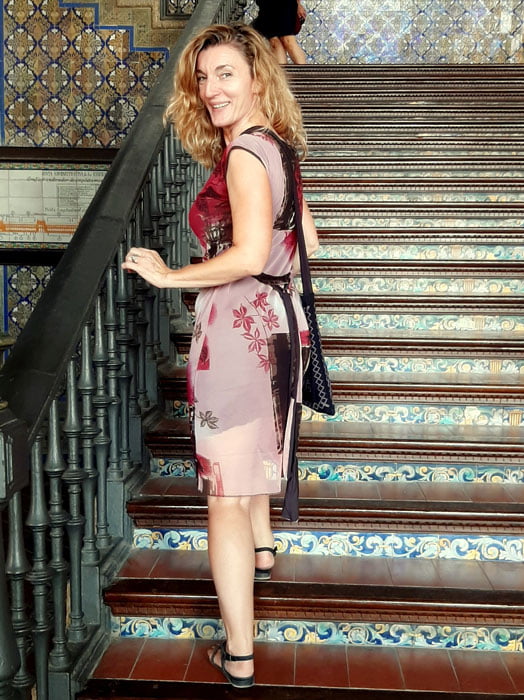
Paid with my credit card and set on the bench to put it all in my bag, when I got the text message from the bank saying that I bought – two tickets?! Oh well, I queued for one counter, then the other, and the third and got to that lady again: “Una persona, por favor, una!” (When one is forced to speak Spanish, even though one doesn’t!) And so, finally, after more than an hour (!), I bought the famous (single!) ticket.

Should I also mention that it took me more than an hour to get to my hotel, that old Spanish ladies were taking me by the hand from one bus to another, all eager to help me find the way (speaking in Spanish all the time which, should I repeat, I don’t), that I was told at the hotel that it’s possible to buy three-day public transportation ticket “at any newsstand”, and it turned out that I had to go to a specific office and waited for 40 minutes… I got to Seville at 11 am, but I took the first photo after 4 pm!
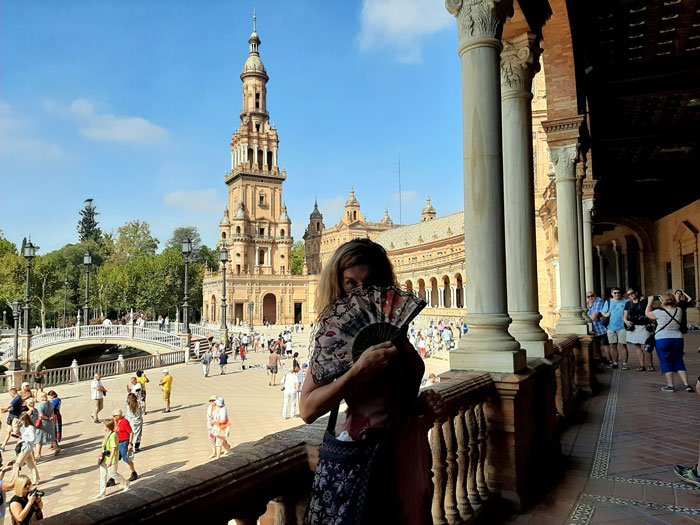
CATHEDRAL AND GIRALDA
The Seville Cathedral is the biggest Gothic building of the kind in the world and it is on the UNESCO World Heritage List. It has been built for the whole century, from 1401 to 1506, at the place where the old mosque stood. The central part is 42 meters high, while the Cathedral spreads to 11,520 square meters. The Big Chapel consists of the altar with 45 scenes from Jesus Christ’s life.
Only the Gate of Pardon (Puerta del Perdon), Patio de los Naranjos and Giralda remain from the old mosque. The bell tower Giralda was once a minaret, built in 1195 after 12 years of intensive work. It’s 103 meters tall.

As soon as I was able to go sightseeing and check out all those things to do in Seville, I hurried to visit the Cathedral. Not only that it’s known to be the largest Gothic cathedral in the world, but it’s also intriguing to see what Christians actually achieved after deciding to erect an astonishing building that would not only outshine the previous mosque but all the similar creations.

TIP: The entry fee is 9 Euros and the audio guide is another 4. The counter might close more than an hour before closing time, so try to come before 16.30. (The Cathedral closes at 17.30.)

You can almost twist your neck when looking at high ceilings. Although the altar seems too decorative in the typically Renaissance style, the overall impression that stays with you is that the Cathedral rather looks simple and elegant. In the central area, you can even queue to take a picture of the ceiling in the mirror.

TIP: The audio guide lasts for 90 minutes, so it’s not advisable to take it if you don’t have enough time or come late.

The first thing I rushed to see was the tomb of Cristopher Columbus. The famous explorer from Genova died in 1506, convinced that he has found a maritime path to Asia. His tomb dates from 1892, while four bearers represent the kingdoms of Castile, Leon, Aragon, and Navarre. (I was always fascinated by the explorers, I even rushed through Lisbon to find the monastery where Vasco da Gama was buried.

It’s possible to climb to the top of Giralda from the Cathedral. ‘Giralda’ in Spanish means “she who turns” because there is a weather vane on the top of it, the statue that represents faith. They say that replicas were often constructed, especially in America, and I do remember seeing one in Cuba – El Giraldillo in Havana.
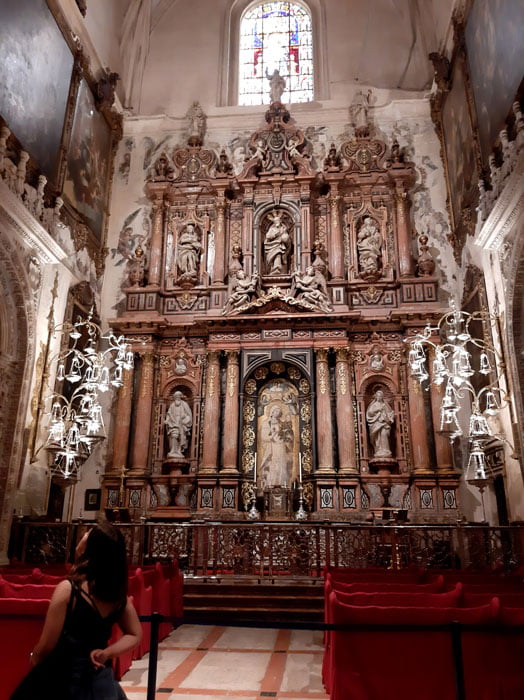
While I was climbing those 35 stories, along the steep path with no steps, I remembered reading somewhere that this Giralda was also a model for building minarets in Rabat and Marrakesh. Moors wanted to destroy it when seeing Catholics being ready to conquer the city because they couldn’t imagine such a scenario that their minaret should serve another faith. But Alphonso X threatened that he would cut anyone “who touches a single stone”. The minaret had three or four copper domes and a crescent on the top which were replaced by bells and a cross. The weather vane was added in the 16th century.

Through small windows along the way to the top one can admire some nice views, but this is also a chance to catch your breath if you are not fit enough since the path is pretty steep.

But the view on the top is the one to take your breath away, not only because there is the Cathedral down below, but you can gaze at the whole city. If you happen to be here at the full hour, one of those heavy bells might strike, blowing away every thought from your head.

Also, expect that the place is crowded, as is the Courtyard of Oranges where Moors once prepared for prayer. One can still find a nice shade amidst all that stone, to take some air and freshen up.

TIP: Make sure to pay attention to the Gate of Pardon on your way out, another authentic part of the Moorish building. (If this is one of the gates, I wonder what the mosque looked like!)

ALCAZAR SEVILLE
This palace was built at the end of the 10th century as a fortification for Cordoban rulers in Seville. Various premises were added throughout centuries, but for the most part, it was erected by king Pedro the Cruel of Castile in the 14th century. He brought the best masons from Cordoba and Granada to build him a palace of prestige.

I have to admit that I didn’t expect that Seville’s Alcazar would look like this. When you visit Granada and Cordoba, you expect that nothing will ever exceed the impression you bring from these surreal towns. Still, the fairy-tale-like halls of the Alcazar made me think again.

TIP: The Alcazar is open until 19.30, but make sure to come early since you will need at least two or three hours to visit it. The entrance fee is 11.5 Euros and you will pay another 6 for the audio guide. Tickets are also sold online through the palace’s office.

When going through the Hall of Ambassadors, I couldn’t help but stare in awe at the colorful ornaments and wall reliefs, or glance between the charming columns with fairy arches (which resemble Madinat al Zahra in Cordoba). And then I took a glimpse of the ceiling. This would be so hard to describe.

Next to this hall, there’s another charming courtyard Patio of the Maidens – like stepping back to the Alhambra of Granada. Intricate Arab arches are supported by columns in the courtyard with a small pond reflecting the building above. Definitely one of the things to do in Seville.

They say that Columbus signed the first contract with Queen Isabel here in the Alcazar and that there are premises on the first floor that were used by the royal couple when they were in town. (They were closed during the time of my visit.) The Alcazar is a perfect guide for the architecture variety since the Moorish style is literally just a step away from the Renaissance.

When you enter the vast garden, it seems natural that the Alcazar was featured in one of the Game of Thrones scenes as Water Gardens of Dorne. Lavish greenery, palm trees and plants, fountains, flowers, and aromatic herbs. The Mercury pond was crowded with tourists. This is where you can cool down a bit in this hot city while enjoying ravishing smells and birds singing.

TIP: Seville is one of the hottest towns in the south of Spain, so make sure to pack light. At the end of September, it was almost as hot as Cordoba (around 34), and 10 degrees Celsius hotter than Cadiz.
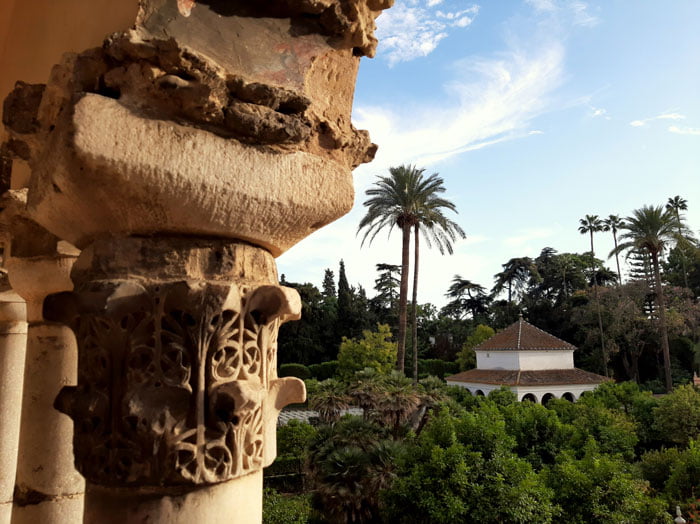
From Alcazar, you will go out to the Santa Cruz quarter and the Murillo Gardens. I often went through the Murillo Gardens those days on my way to the Prado de San Sebastian with all the buses, trams, and metro. A nice walk through thick greenery, like being away from the city center.
TIP: Those of you into arts will be thrilled to hear that the work of the renowned 17-century painter Bartolome Esteban Murillo is kept in the Museum of Fine Arts. Murillo was born here.
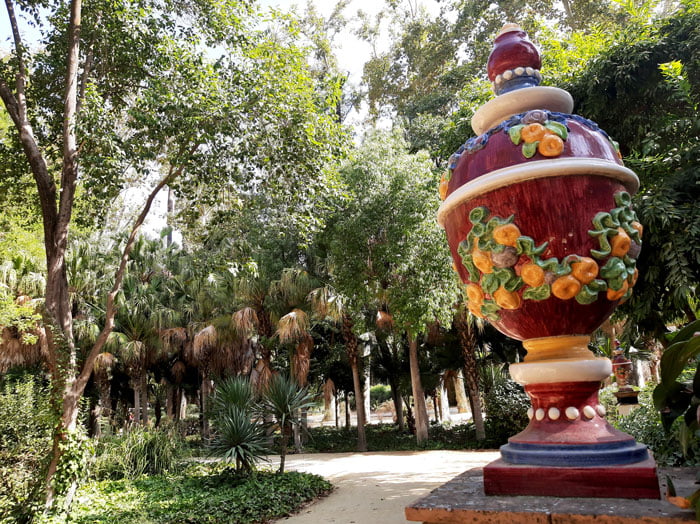
PLAZA DE ESPANA
The Spanish Square is built for the purposes of the Ibero-American exhibition in 1929, along with a few pavilions nearby. The 500-meter channel is adorned by four bridges representing the four Spanish kingdoms. The whole square is as vast as five football stadiums. There are 48 benches and niches along the plaza that represent Spanish provinces and are decorated with historic scenes displayed in ceramic tiles.

For some, the Plaza de Espana is a bit kitschy, while others love it. I was impatient to see it and wasn’t disappointed. ‘Things to do in Seville’ list wouldn’t be complete without visiting the Plaza, that’s for sure.

I was looking for the Cordoba niche, stopped to see flamenco dancers, walked over small bridges, and climbed to terraces for the best view.

This is also the place to buy some souvenirs, specifically colorful fans, and to admire ceramic tiles. It’s possible to take a ride in a carriage or to rent a boat (five Euros per ride). I was also surprised that there were government offices on the first floor.

GUADALQUIVIR RIVER
This is the second-longest river in Spain (657 km). It goes all the way from Sierra de Cazorla, through Cordoba and Seville to the Cadiz bay, where it flows into the ocean. In the Roman times, ships went to Cordoba, but nowadays the navigation is limited to Seville.
The overseas expeditions, thus, took off from Seville, since it was easy to reach the ocean from here. Columbo did it in 1492, but also Ferdinand Magellan in 1519.

You can find out more about the river on the Tourism of Seville website, but you should certainly walk along its banks. The river is close to the historic city center. There are various cafes with a view of the river.
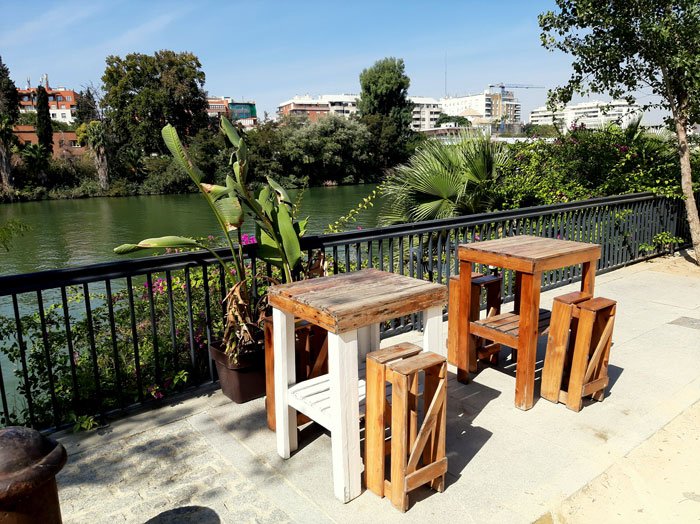
Another thing to do in Seville is a visit to the Torre del Oro or the Golden Tower. Built in 1220 as part of the Moorish city walls with 166 towers in total, it was later used as a storage for goods brought from Mexico and Peru. The story says that its name refers to the golden tiles that the tower was covered with, but also to the wealth which came from America. There is the Maritime Museum to be seen inside with some great views of the city from its balcony.

Not that far from here, right next to the Cathedral, there is another building declared a World Heritage Site by UNESCO – the Archivo General de Indias. This 16-century building now houses more than 80 million pages of documents and maps from the journeys to Indias.

Across the street from the Golden tower, it’s hard to miss a white building with yellow windows – the famous bullfighting arena Maestranza. Bullfighting was born in Ronda and Seville in the 18th century and their arenas are considered to be the oldest in Spain. According to local beliefs, the matador who fights in Seville is to become famous. Bullfights are still held here, in spite of the rising public resentment. The season starts after Easter and lasts until October with about 20 fights per year.

TIP: A tourist visit to the bullfighting arena is only possible accompanied by a local guide and costs 8 Euros. Tickets for the actual bullfighting are sold at the same counter and range from 7 to 70 Euros.

There are numerous restaurants and tavernas along the riverbank, with some specializing in flamenco where you can book your dinner with a show.

If you continue in the same direction by bus, you will reach the quarter called La Macarena, named after one of the most respected statues of the virgin among Sevillians. It can be seen at the Basilica de la Macarena with its walls painted yellow. (Yep, the song also originated from Seville, about the girl bearing the same name.)
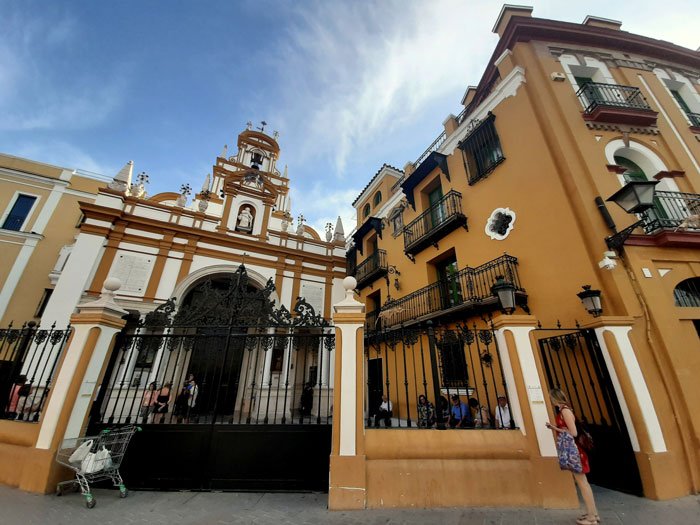
A lot of houses here were renovated, but you can still come across old crumbling facades. This neighborhood is popular among artists and houses rooms for performances and workshops. It should be mentioned that the Basilica is located next to the Gate of Cordoba and the Gate of Macarena which were both old Moorish gates for entering the former Arab city.

The map took me through the narrow streets towards the Plaza Alameda de Hercules, the square where people usually come for tapas, and I was trying to find columns of Caesar and Hercules. This is where the Roman temple dedicated to Mars, the god of war, once stood.

After15 mins or so you will reach another must-see among things to do in Seville – the Metropol Parasol that Sevillians simply call Las Setas (mushrooms). It consists of six huge wooden parasols that are connected and resemble waffles. There is the Archeology Museum underground with certain remains that were excavated when workers were trying to dig out the parking lot, market and various restaurants to be found on the ground floor, a vast pathway and shade on the first floor, and a 360-degree viewpoint on the top.

SANTA CRUZ DISTRICT
One of the most visited neighborhoods in the city because of the authentic atmosphere, narrow streets, tavernas and tapas bars, was almost demolished for the Expo 1929, planning to build a wide, modern avenue instead. It was formerly known as the Jewish Quarter and most of its churches were once synagogues. The district is located near the Alcazar and the Murillo Gardens.

Make sure to leave at least one afternoon to spend it here – to stroll around and have lunch and coffee. Tacked away streets and courtyards with small tables set in cobblestone patios are more than charming.

I found a café with homemade cakes “according to nuns’ recipes”. If I am not mistaken, the cake was called the “tocino de cielo”.
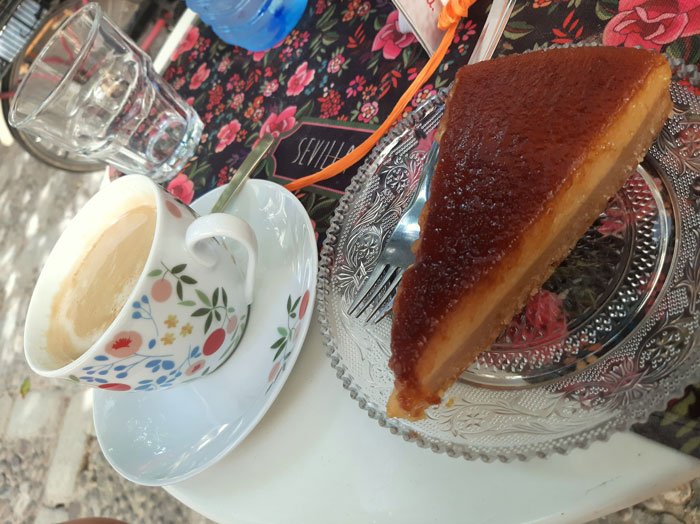
I also found a bookmark here with a painted flamenco dancer and a matador… It’s interesting to know that the bullring here was visited by Hollywood actress Rita Hayworth in 1960 – her father was from Seville – and her husband Orson Welles who was also a great bullfighting admirer. (They even erected him a monument in Ronda!)
Next: HIGH-SPEED TRAIN TO CADIZ
The full ANDALUSIA series

If you need a freelance travel writer or you would like to see your country, city, flight, etc., presented on the blog, drop me an email.
Find our more on Freelance Travel Writer page.
I am looking forward to working with you.




12 responses
Oh man, all of that incredible architecture is making me drool! I love the look of Spanish and colonial-style buildings. The attention to detail is just fabulous.
I can so relate to that! I was stunned by all the Moorish legacy buildings. It’s just fascinating to see all that in person.
Thanks, Kevin. 🙂
What an amazing place!!! I love checking out old architecture!! Especially drawned to the Christopher Columbus tomb.. that is something that I definitely want to see!!
So glad you find this helpful. There really are some great landmarks to visit in Seville. I just love the Moorish architecture. <3
Thanks, Andrzej, for stopping by.
Love the incredible architecture and attention to detail. So beautiful and stunning. I visited Catalonia about 2 months ago and now I’m intrigued to visit the South of spain. I really enjoyed reading about seville as it is one of the cities I want to go visit. Can’t wait to see the tomb of Christopher Columbus. Great read!
Thank you, so glad you like the post. 🙂
Catalonia is pretty different from the south of Spain. Actually, I don’t think that any other part of the country can really be compared to Andalusia. The whole province is mesmerizing. (There’s more from Andalusia on the blog, feel free to browse around.) I’m sure you’d love Seville, there’s so much to see.
I’ve spent a little time in Barcelona, but haven’t managed to make it through the rest of spain – seville is high on my list just for it’s architecture – looks truly amazing. The Seville Cathedral in particular – WOW! Thanks for the tip on climbing to the top of Giralda – the views are spectacular! Hopefully I’ll have the chance to visit in 2020 – appreciate the recommendations 🙂
If you are into architecture, make sure not to miss the Alcazar, since this is a true wonder of the Moorish legacy.
Hope you’ll have some great time in Seville. So glad you like the post. <3
Wow, this is so beautiful…the architecture, details, even the ceramic used. I want to see this place soon 🙂
The whole of Andalusia is well known for the centuries-old-tradition of using colorful tiles. So many patterns, it’s breathtaking.
The largest green space in central Seville originally belonged to the nearby San Telmo Palace, dating to the 15. The park s broad avenues have twin-rows of tall palm trees, while the body of the park, woven with little trails, is a large botanical garden with unusual species from around the world.
Thanks for the info. Lovely, right! 🙂